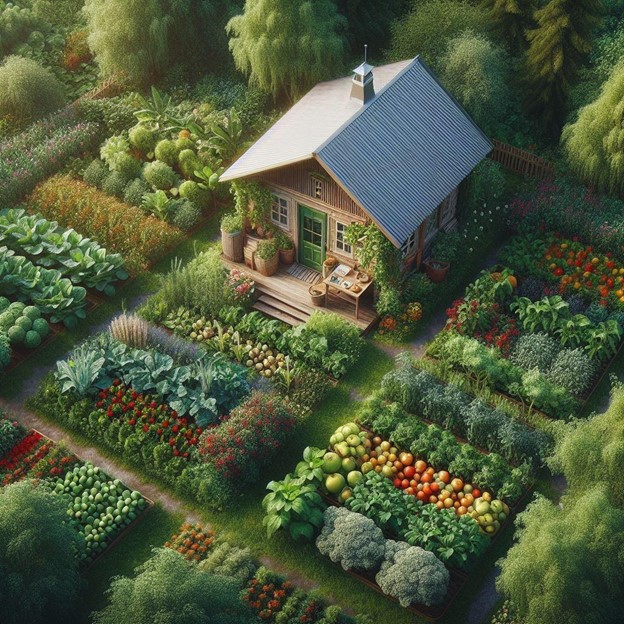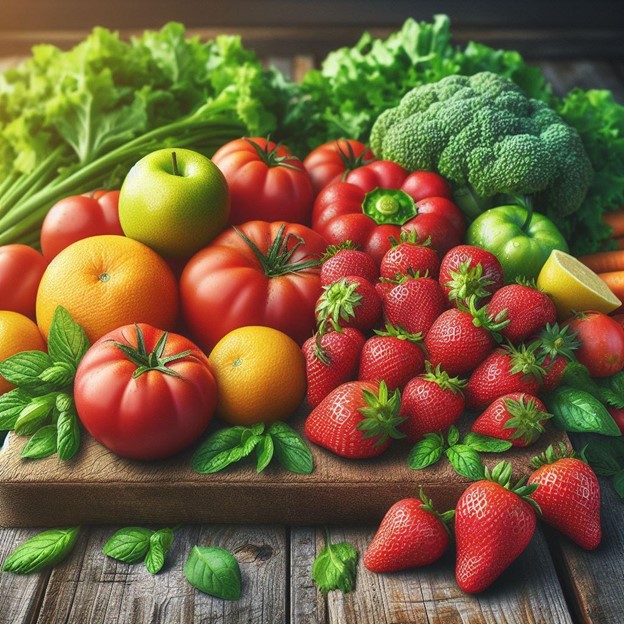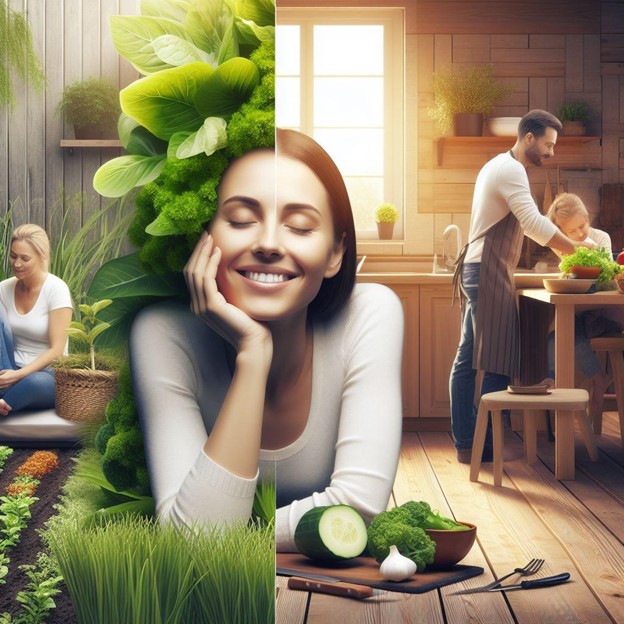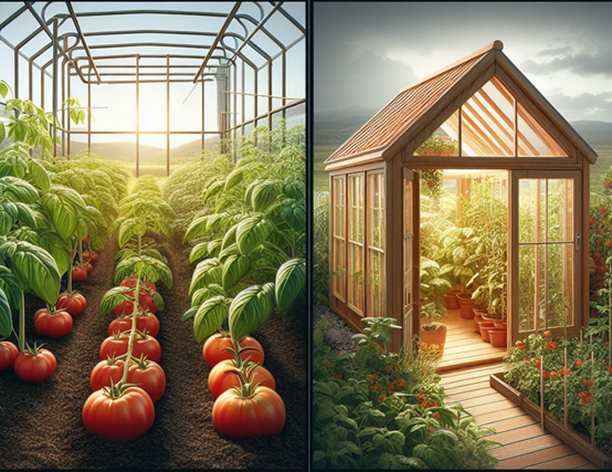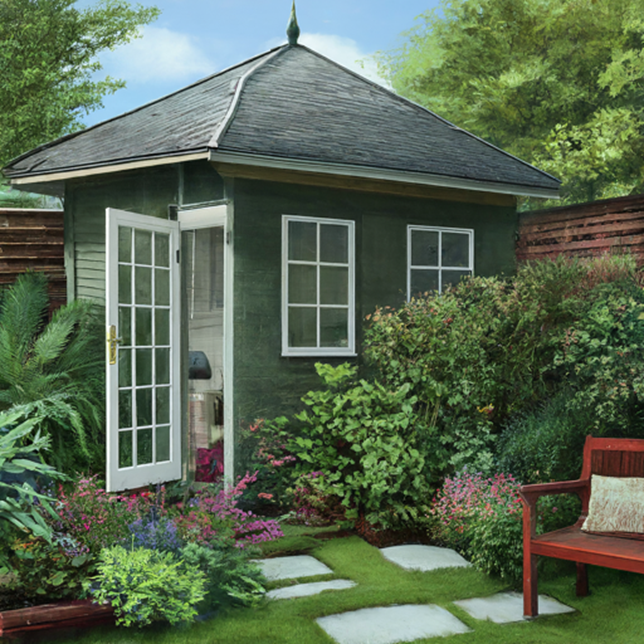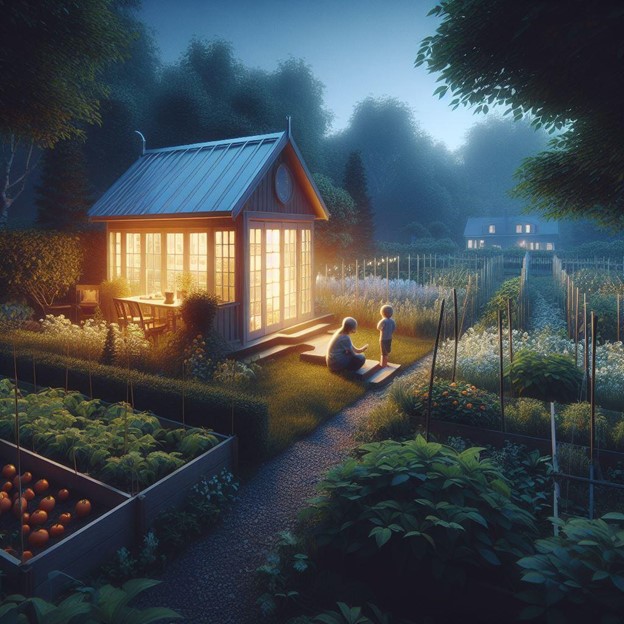Image by MS Designer
Experiencing an increased interest in gardening to keep up with the cost of food, gardeners across the UK are discovering the many other benefits to cooking up homegrown feasts. The joy, taste, and health benefits are magnified with smashing dinners using homegrown fruit and veg. Using a summer house is an ideal way to grow produce at home and lengthen your gardening season. Below, we highlight the benefits of ditching supermarket produce and explore how a summer house can help you on your journey.
Image by MS Designer
Self Sufficiency: Not Just a Trend
A study from the University of Sheffield revealed that people who grow their own produce consume more fruit and veg in their diets than people relying on supermarkets. Recent economic problems have sparked a lot of people’s interest in growing their own food at home.
The financial and health benefits are clear, but making full use of their outdoor space as a whole is also motivating people to continue their journey to self sufficiency. Many people who once ignored their gardens completely are now revelling in a new found love for the outdoors. Taking advantage of our four seasons, people are exploring the possibilities of home grown cooking and reaping the benefits, including:
- Economic peace of mind: Witnessing the sharp rise in prices the past few years had many people wondering, “what if fruit and vegetables became completely unaffordable?” Home growing fruits and vegetables provides you some comfort in knowing you have access to fresh food, no matter what supermarket prices do.
- Greater quality control: We often control so few factors about the food we put into our bodies and how we live our lives. By growing food at home, you are back in the driving seat. Selecting soils, fertilisers, and techniques to use for you and your family, you can eliminate unhealthy options, or go completely organic for an even healthier diet.
- Renewed interest in cooking: The UK’s interest in cooking at home and experimenting with cuisine has been on the rise for years. When we create these delicious and fresh harvests from our very own garden, we create experiences to remember.
- Remembering our roots: Before the supermarket was the go-to option for our every need, humans worked with the nutrient dense soil we are blessed with and formed an attachment with the land, the weather, and the seasons. When people rediscover working with the land, even in a small summer house, growing food brings a familiar joy.
Image by MS Designer
The Health Benefits of Homegrown Food
Cooking up new recipes with home grown fruit and vegetables is much more than a fun hobby. It has health benefits! Supermarkets are very convenient for our modern lifestyles, but we pay the price for that ease in other ways. By returning to growing our own food, we benefit from:
- Greater nutrient density: When we harvest fruits and vegetables they start losing their nutrient content immediately. Some produce can lose up to 50% within two days of harvesting. Transportation of food to supermarkets can take several days, or sometimes several weeks. This means we never get the full benefit of nutrients from supermarket fruits and vegetables.
- Fresher taste: Farmers and gardeners know that when you start tasting the fresh spoils of homegrown food, it’s hard to return to supermarket life. The succulent sweetness of fresh summer strawberries or the earthy, buttery taste of home grown potatoes make us more likely to want to eat a healthy diet.
- A wider range of fruits and vegetables: Exploring the world of fruit and veg by gardening with heirloom seeds allows you to grow varieties of produce you won’t find at the shops. This greater variety offers different antioxidants and nutrients to nourish your body with the full spectrum of nature’s bounty.
Image by MS Designer
Physical and Mental Health Benefits of Cooking with Homegrown Food
Discovering dishes from around the world and preparing them with your own produce offers benefits beyond nutritional advantages. The process of cooking and gardening provide health benefits all of their own, including:
- Stress relief: The focus we have in the present moment when we tend our plants or carefully craft new dishes in the kitchen immediately distracts us from our stress. As we make progress in the kitchen and garden, we get boosts of endorphins along the way, the feel good hormones that make us happy.
- Accomplishment: Gardening and cooking create wins. And sometimes we need those vital wins after a hard day. Seeing the fruits of our labour boosts our confidence and ignites our passion and curiosity.
- Learning: We feel good when we learn something new. When we discover new dishes from around the world or work with a new ingredient for the first time, we expand our knowledge and boost our confidence.
Image by MS Designer
Using a Summer House to Advance Your Home Garden
There are many ways you can set up a home garden to grow your own fruits and vegetables, and many of them are easy and affordable.
Using a summer house to start your growing journey helps you to:
- Start plants in ideal conditions before they move into the ground
- Use the protective, light filled summer house to keep plants safe and warm
- Store gardening tools to avoid rust and keep everything handy
- Create a relaxing gardening workspace that inspires your love of growing
- House your garden pots in a beautiful structure that makes your garden pop
Image by MS Designer
How to Maximise Your Summer House For a Great Garden Yield
Using a summer house for a great garden yield is a new idea to many folks. Often people think of a summer house as the place you might put your garden chairs while they gather dust and wait for good weather. But a summer house has so much more potential for your garden, especially for growing food.
When you take the plunge and decide to start your summer house gardening journey, there are a few things that can help improve your chances for success. Consider using some of the following tips to speed up your progress and avoid some common pitfalls.
- Companion planting: One of nature’s sweetest secrets! When certain plants are grown in pots together, they can increase each other’s yield and even repel pests. Tomato and basil plants are a classic example of companion plants – they even taste delicious on a plate together!
- Consider pest control: No matter the time of year, there will be some crawling or furry neighbours hoping to get in on your free garden buffet. Although commercial pesticides are available, there are many natural alternatives for gardeners sticking to organic methods. Aphids are a common foe for home gardens, but can often be repelled by planting delicious garlic.
- Create a microclimate: Using your summer house or surrounding area, you can create a microclimate inside, keeping conditions closer to ideal for your chosen crops. Using the structure of the summer house, warmth of surrounding brick walls, and shading techniques, you can increase your crop yield for cooking all year round.
Image by Gemini
Home Growing Challenges
Starting to grow delicious fruits and vegetables at home can pose some initial obstacles. The key to gardening success is often finding your can-do attitude. Learning how other people are getting around their challenges makes a big difference and finding a community can be very valuable. Here are some of the most common obstacles to home growing success and how people make it work:
Space considerations
For gardens with a small growing area or a lack of sunlight, growing food can be more tricky, but not impossible. Sometimes we simply need to change perspective. By using a summer house, shed, or greenhouse in a strategic spot in your small space, you can maximise the light and heat in your space to create a growing environment.
Initial investment
Although home growing can save us a lot of money over a lifetime, there is some initial investment to get started. The good news about gardening is you can start as small as you wish. Just a few herbs on a windowsill, a single barrel of potatoes, or a pot of juicy tomatoes can slowly build up into a full, productive garden.
Limited time
When you are working a full week and raising a family, finding the time to garden might sound nice, but feel impossible. The key to success in this area is building a garden that fits your lifestyle. If you have limited time, start with some fruit or veg that takes very little maintenance to begin. You can also consider starting a joint project with a neighbour or friend.
Overcoming Summer House Issues
No new journey is without its potential pitfalls and gardening with the help of a summer house is no different. Fortunately, many of the most common problems people experience can be prevented with simple, regular maintenance, including:
Avoiding Condensation Trouble
As seasons change, summer house maintenance needs change. The same is true of our homes. Just like your house, your summer house needs good airflow all year round to prevent mould, mildew, and odours from building up. Simple steps, such as opening the doors and allowing fresh air to circulate can keep it smelling fresh, looking clean, and prevent problems.
Structural Problem Prevention Is Better Than Cure
It may have been your grandma’s favourite saying, but there is so much truth in this old wisdom. Many expensive or time consuming summer house repairs are due to a lack of regular maintenance. By checking your summer house frequently for cracks, holes, and other small issues, you can avoid mega tasks due to rot or structural problems.
Regular Wood Treating
Even your summer house deserves a facial every now and then. By treating it with wood oils, stains, or moisture repellants, it becomes less prone to damage and keeps its beautiful style for years to come.
Image by MS Designer
Finding the Perfect Summer House
Budding gardeners have a huge variety of beautiful, strong summer houses to choose from. It can be tricky to know where to start. Consider some of these factors as you narrow down the perfect option for your garden:
- Choose your spot wisely: To help your plants get off to a good start and keep a cosy temperature, light is vital. While a south facing spot is ideal, any area in your garden that receives a good amount of light everyday will work. A corner summer house can even capture light coming in from awkward diagonal angles.
- Go glass heavy for growing: If you want to grow your fruit and veg directly inside your summer house, a structure with lots of window light is needed. Glass structures allow light and heat to flow in, creating the perfect conditions for a good yield.
- Keep both your budget and the future in mind: Waiting to start your garden culinary journey until you can afford the fanciest summer house is not recommended. That said, thinking about the future is also a good idea. Starting is the key. Starting where you are budget wise helps to start your project as soon as possible. If you have a little more budget wiggle room, consider a model with durable features to reduce maintenance and improve its lifespan.
Image by MS Designer
In Conclusion
From grocery backup plans for tough times, to the passion ignited when cooking with your own produce, a garden summer house can help your dream come to life. Serving as a growing space, a storage space, and a spot to relax throughout the seasons, more and more people are discovering its benefits.
Whatever the size of your space, or your garden goals, Garden Buildings Direct can help you start your journey. The sooner you start growing, the sooner you can enjoy the delicious fruits of your labour!

